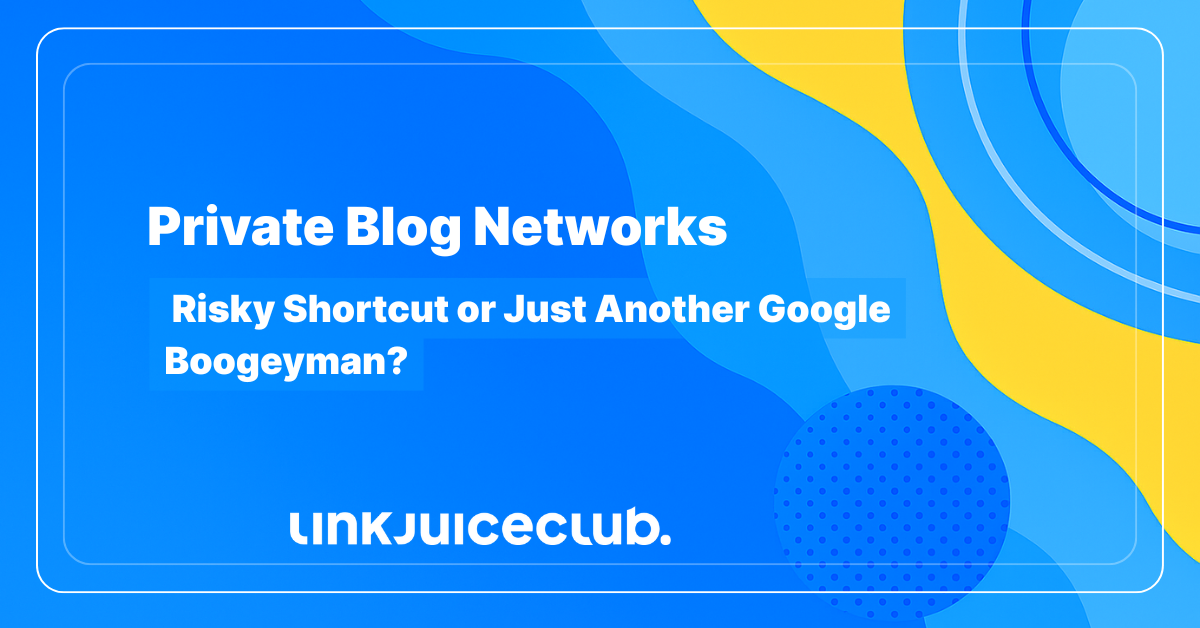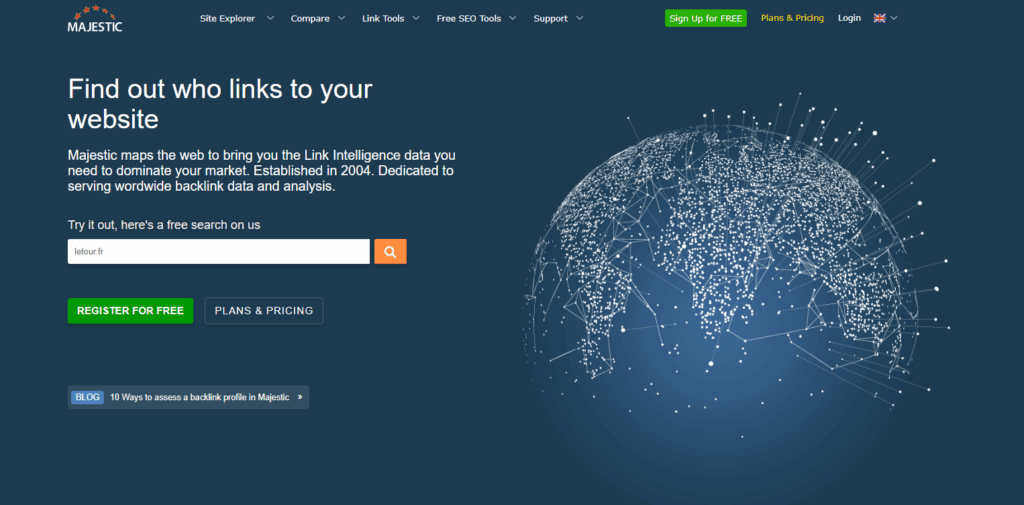
Private Blog Networks: Risky Shortcut or Just Another Google Boogeyman?
Say the phrase Private Blog Networks out loud in the wrong room and watch the panic spread (no joke!).
Publicly, it’s a no-go zone. You’ll get the usual sermon: They violate Google’s rules, PBNs are black hat, You’ll get penalized.
But hop into a private Slack channel or Discord server and you’ll see a different world entirely – sites climbing to the top of brutal SERPs off the back of nothing but cleverly aged domains, masked footprints, and a well-oiled spreadsheet.
So what’s the reality?
Are Private Blog Networks a guaranteed red flag for deindexation? If that’s not the case, how can they be handled properly? Let’s try to find out!

Breaking It Down: The Real Meaning of Private Blog Networks
Let’s cut through the jargon! A Private Blog Network is exactly what it sounds like: a network of websites that you, and only you, control.
These aren’t fan pages or passion blogs. They’re tactical assets, often built using aged or expired domains, designed for one specific reason: to pass link equity to your money site and climb the SERPs.
Imagine this: You’ve just launched a cutting-edge tech comparison site. Instead of sitting around hoping someone answers your emails, you snag a bundle of aged tech blogs that used to cover gadgets, reviews, and industry trends.
You spin them back to life with clean hosting, relevant content, and (follow this) contextual links pointing directly to your top pages using anchors like best AI laptops or budget smartphone guide. That’s how modern SEOs quietly build power.
It’s fast, it’s controlled, and it works (when done right, of course).
But what makes PBNs so appealing to SEO tacticians?
Control. You get to dictate every major lever of link building:
- You decide the anchor text, so you’re not stuck with random branded terms or click here.
- You choose the exact page that gets the boost, whether that’s a homepage, product page, or blog post.
This is the polar opposite of outreach roulette. You’re not sending cold emails hoping someone gives you a shot.
And you’re definitely not shelling out $300 for a guest post on a DR50 site that hasn’t ranked for anything since 2017!
Why PBNs Break the Rules (And Still Work Anyway)
Let’s not sugarcoat it; yes, Private Blog Networks go against Google’s official guidelines. The search giant lumps them into the category of manipulative link schemes, alongside excessive link swaps and links from spammy directories.
But here’s the catch: what Google’s public-facing team says and what its algorithm actually enforces aren’t always in sync.
Googlebot isn’t judging your morality; it’s scanning for signals. If your PBN looks like a real site, publishes useful content, links out naturally, and keeps its structure clean, the algorithm won’t throw a red flag just because you own it.
What matters is the trust profile of the domain, the topical relevance, how the link is positioned within the content, and whether it fits into a natural backlink pattern.
So, get those things right, and your PBN will glide quietly under the radar, doing exactly what it’s meant to do.
The Real Risk? It’s Not Google… It’s Exposure
Ironically, the biggest threat to your PBN isn’t the algorithm; it’s other SEOs. Most so-called private networks aren’t private at all. They’re openly traded in shady link marketplaces, shoved into Fiverr gigs, or offered through forums where Google’s quality team can easily pose as a buyer.
Once your network ends up in someone’s backlink audit, leaked in a pitch deck, it starts bleeding trust. That’s when the red flags start flying, and it’s only a matter of time before the domain becomes toxic.
This is why seasoned operators don’t rent out their PBNs to strangers. They keep them close, used exclusively for their own affiliate projects, high-retainer clients, or trusted peers in invite-only groups.
The moment you start selling mass access to your links, you’re waving a big, shiny spam me flag, and Google’s link graph analysis is far more sophisticated than most people realize.

When to Use PBNs in 2025 (And When to Steer Clear)
Simply put, timing and control are everything. If you use PBNs in a smart way, you’ll be able to break into competitive SERPs fast.
Use them recklessly, and you could end up burning through domains, budgets, and trust.
When PBNs Make Sense
👏 You need fast domain authority without waiting six months for outreach to work
Launching a fresh project? Instead of playing the long game with slow-moving guest post campaigns, PBNs can give you that early push, allowing you to skip the DR 0–20 crawl and get Google’s attention sooner.
👏 You want controlled anchor testing at scale
Need to see how an exact match anchor behaves in the wild? Want to test link velocity or page-specific impact? PBNs give you the ultimate sandbox, because you call every shot.
👏 You’re working with local clients or budget-constrained sites
Not every client has $4K/month to blow on digital PR. PBNs are a practical, cost-effective way to boost rankings for local businesses that need results, not white papers.
When PBNs Are a Bad Idea
🚫 You’re building a long-term brand you plan to sell
If your goal is an exit or acquisition, PBNs are a red flag during due diligence. Buyers want clean, scalable strategies, not networks they have to worry about maintaining or explaining.
🚫 You’re relying entirely on a single network to rank
If your whole plan revolves around one PBN to hold your positions, you’re playing SEO on hard mode. Diversify your sources. Always.
🚫 You’re already sitting on a risky link profile or manual penalty
Adding more sketchy signals to a site already under scrutiny is a fast way to get into big trouble. PBNs should amplify a balanced strategy, not patch a broken one!
Building a Private Blog Network That Doesn’t Blow Up
If your PBN strategy involves scooping up random expired domains, slapping AI content on them, and linking out like there’s no tomorrow, you’re not building a network.
You’re assembling a digital minefield. It might look fine at a glance, but in English-speaking SERPs, that shortcut is going to get you flagged fast.
If you’re serious about doing this right in 2025, here’s what your buildout should actually look like.
1. Choose Domains With Real Weight, Not Junk Metrics
Everything starts with the domain. Think of it as the foundation of a building!
You want domains with trustworthy backlink profiles – no ancient casino spam, pharma redirects, or burned-out affiliate footprints.
Ideally, you’re finding sites with natural branded anchors, backlinks from real authority sources, and homepage-weighted links that signal legitimacy. Before committing, use tools like Ahrefs or Majestic to double-check whether those links are still live and dofollow.

2. Host Like a Ghost, Separate Everything
This is where rookies get wrecked. It’s not enough to buy solid domains; you need to treat each one like its own standalone brand.
Never host multiple PBNs on the same server, IP, or cheap reseller account. And never reuse analytics scripts, tag managers, themes, or even plugin stacks.
To stay off the radar, register each domain with a different provider and host every site on its own separate hosting account. Vary your CMS platforms when possible; WordPress is great, but mixing in Ghost, HTML, or even Webflow makes you harder to trace.
3. Let It Breathe Before You Drop the First Link
The difference between getting flagged and flying under the radar often comes down to one thing: patience.
Start by launching your PBN site with actual structure. Create five to ten pages of content that mimic a real niche blog.
Include essentials like About and Contact pages, along with useful how-tos, roundups, or listicles related to the site’s topical focus. Nothing spammy, nothing salesy, just solid content that wouldn’t look out of place on a real hobbyist or enthusiast site.
Once the site is live, leave it alone. Seriously. Give it two to three weeks to get crawled and indexed naturally.
4. Don’t Link Like a Spammer
Once the site is stable and crawling regularly, it’s time to add links, but not like a rookie.
Start by using a healthy mix of anchor text. Branded anchors should dominate your profile, with partial match and long-tail sprinkled in strategically. Raw URLs and generic phrases like click here help keep things natural.
Don’t forget outbound diversity! Linking to other high-authority domains shows Google your site plays well with others.
As for format, vary your link placements. Some can sit inside paragraphs, others can anchor an image or serve as a button. The more natural the distribution, the harder it is to fingerprint.
5. Make It Look Like a Legit Site, Not a Link Dump
No one’s buying the idea that a one-page blog roll with no images and a stock theme is a real website. If you want your PBN to work, you need to dress it up like it actually matters.
That means designing a homepage that doesn’t just auto-list the latest blog posts. Add category navigation, build out sidebars, include contact forms, quote blocks, and multimedia.
Also, use images, embed a YouTube video or two, and make the layout clean and responsive.
Google’s algorithm rewards sites that look and feel structured. So give it exactly what it wants, a site that looks better than the average blog in your niche.
6. Tiered Linking: The Safety Net Strategy
Direct links to your money site can be risky, especially if your PBN footprint isn’t bulletproof. That’s where tiered linking comes into play. Instead of aiming your PBN firepower straight at your core pages, you build a buffer.
Send those PBN links to secondary properties: a guest post you’ve published, a high-authority Web 2.0 page, or even a niche edit sitting on a forgotten DR40 blog.
If something trips a wire, it’s your buffer link that suffers, not the site paying the bills.
7. Stay in Control: Tracking and Tuning Your PBN Assets
Running a PBN isn’t a set it and forget it tactic. If you’re not actively monitoring your network, you’re leaving yourself wide open to penalties, deindexation, or wasted resources.
Each month, perform a full sweep. Check that your sites are still indexed, that your outbound links are live, and that nothing’s been flagged or hit with manual actions.
Track more than just whether a link is live – track performance. Does your target page move after the link goes live? Is the anchor text performing better than others? Are there unexpected dips in traffic?
And if a PBN site doesn’t deliver after six months? Don’t waste it. Re-theme it, refresh the content, shift the hosting setup, and reposition it in a new cluster.

Are PBNs Still Worth It?
Let’s be honest, PBNs aren’t some mythical relic from the black hat archives. They’re still alive, still effective, and still triggering debates everywhere from Reddit threads to SEO agency Slack channels.
But here’s the thing: not all PBNs are created equal. The ones that get hit are sloppy. The ones that win are smart. If you’re going to play this game, you need to operate at a higher level.
Here’s what separates profitable networks from penalty magnets:
- Built like real websites – No half-baked shell sites or AI gibberish. You need solid content, logical site architecture, and a genuine user experience.
- Hidden in plain sight – Mask hosting, rotate CMSs, and vary designs. The more natural the footprint, the harder it is to spot.
- Anchors that blend in – Forget exact match spam. Smart anchor distribution makes your link profile look natural, not needy.
- Careful with link velocity – Matching pace to site history and content volume is key. It’s not about how many, but how believable they are.
Do it right, and you’re not just avoiding penalties, you’re quietly leapfrogging sites playing by Google’s official playbook.
Key Takeaways: What PBN Success Actually Looks Like
If there’s one thing this whole conversation should make clear, it’s this: building a PBN that actually works isn’t about shortcuts, it’s about control, precision, and patience!
You’re not trying to game Google. You’re building a signal engine you fully own. And when executed properly, that’s one of the most scalable, powerful link strategies available.
The barrier to entry has gone up – higher quality domains, cleaner builds, more planning – but so has the payoff. Most SEOs won’t put in the work. They’ll cling to white hat limitations and wonder why they’re stuck on page three.
So let them.
Because while they’re quoting guidelines, you’ll be out there claiming rankings, driving revenue, and setting the pace.
Not because you broke the rules, but because you built smarter than everyone else.





